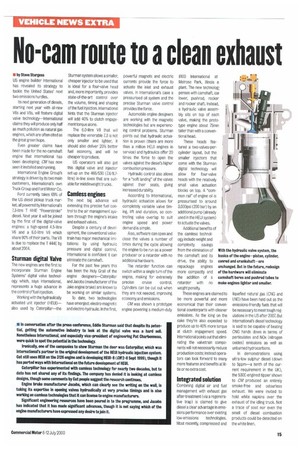No-cam route to a clean exhaust
Page 17

If you've noticed an error in this article please click here to report it so we can fix it.
• by Steve Sturgess US engine builder International has revealed its strategy to tackle the United States' next two emissions hurdles.
Its next generation of diesels, starting next year with all-new V6s and V8s, will feature digital valve technology—International claims they will produce only half as much pollution as natural gas engines, which are often cited as the great green hope.
Even greater claims have been made for the no-camshaft engine that International has been developing; CM has now seen it installed and running.
International Engine Group's strategy is driven by its two main customers, International's own Truck Group and Ford Motor Co.
Ford currently takes 65% of the US diesel pickup truck market, all powered by International's 13-litre T 444E "Powerstroke" diesel. Next year it will be joined by the first of the digital-valve engines: a high-speed 4.5-litre V6 and a 6.0-litre V8 which share 90% of their parts. The V8 is due to replace the T 444E by about 2004.
Sturman digital Valve
The new engines are the first to incorporate Sturman Engine Systems' digital valve technology which, says International, represents a huge advance in the control of fuel injection.
Working with the hydraulically actuated unit injector (HEUI)also used by Caterpillar—the Sturman system allows a smaller, cheaper injector to be used that is ideal for a four-valve head and, more importantly provides state-of-the-art control over the volume, timing and shaping of the fuel injection, International hints that the Sturman injector will add 40% to clutch engagement torque alone.
The 6.0-litre V8 that will replace the venerable 13 is not only smaller and lighter, it should also deliver 20% better fuel economy, and will be cheaper to produce.
US operators will also get this digital valve and injector set-up on the 466/530 (7.6/81litre) in-line sixes that are suitable for middleweight trucks.
Camless engines
The next big advance will extending this precise fuel control to the air management system through the engine's intake and exhaust valves.
Despite a century of development, the conventional valvetrain has major mechanical limitations: by using hydraulic pressure and digital control, International is confident it can eliminate the camshaft.
For the past few years this has been the Holy Grail of the engine designers—Caterpillar and Jacobs (manufacturer of the Jake engine brake) are known to be working on similar systems.
To date, two technologies have emerged: electro-magnetic and electro-hydraulic. In the first, powerful magnets and electric currents provide the force to actuate the inlet and exhaust valves. In International's case a pressurised oil system and the precise Sturman valve control provides the force.
Automobile engine designers are working with the magnetic technologies but are experiencing control problems. Sturman points out that hydraulic actuation is proven (there are more than a million HEUI engines in service) and hydraulics offer 20 times the force to open the valves against the diesel's higher combustion pressure.
Hydraulic control also allows for a "soft landing" of the valves against their seats, giving increased durability.
According to International, hydraulic actuation allows for completely variable valve timing, lift and duration, so controlling valve overlap to suit engine speed and power demand is simple.
Also, software can open and close the valves a number of times during the cycle allowing the engine to be run as a power producer or a retarder with no additional hardware.
The retarder function can switch within a single turn of the engine, making for extremely precise cruise control. Cylinders can be cut out when they are not needed, improving economy and emissions.
CM was shown a prototype engine powering a medium-duty 8100 International at Melrose Park, Illinois e plant. The new technolog; penses with camshaft, car lower, pushrod, rocker and rocker shaft Instead, a hydraulic valve assembly sits on top of each valve, making the prototype engine about 75mrr taller than with a conventional head.
These heads featured a two-valves-percylinder layout, but the smaller injectors that come with the Sturman digital technology will allow for four-valve heads with the relatively small valve actuation blocks on top. A "common rail" of engine oil is pressurised to around 3,000psi (200 bar) by an additional pump (already used in the HEUI system) to actuate the valves.
Additional benefits of the camless technology include weight and complexity savings from the elimination of the camshaft and its drive, the ability to repackage engines more compactly and the addition of a retarder with no weight penatty.
These engines are claimed to be more powerful and more economical than their conventional counterparts with cleaner emissions. As the icing on the cake they're also expected to produce up to 40% more torque at clutch engagement speed. International points out that eliminating the valvetrain components will not necessarily reduce production costs; instead operators can look forward to many more features and benefits at little or no extra cost.
Integrated solution
Combining digital air and fuel management with exhaust gas after-treatment (via a regenerative trap) is claimed to give diesel a clear advantage in emissions performance over existing
low-emissions technologies. Most recently compressed and liquefied natural gas (CNG and LNG) have been held out as the emissions-friendly fuels that will be necessary to meet tough regulations in the US after 2007. But International's diesel technology is said to be capable of beating CNG hands down in terms of particulates and NOx (nitrogen oxides) emissions as well as unburned hydrocarbons.
In demonstrations using ultra-low sulphur diesel (down to 5pprn—a tenth of the current requirement in the UK), the 530E-engined tipper shown to CM produced an entirely smoke-free and odourless exhaust. We were invited to hold white napkins over the exhaust of the idling truck. Not a trace of soot nor even the smell of diesel combustion products could be detected on the white linen.




















































































































